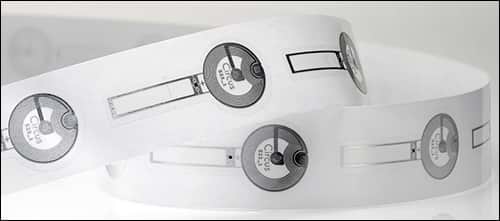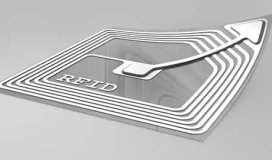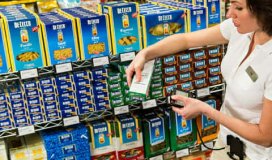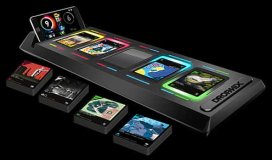As part of a series of RFID-based products for authenticating high-value products and goods, Smartrac has released its Circus Tamper Loop tag, the latest in the technology company's Near Field Communication (NFC)-based Circus product line. The tag is being sold in samples to companies such as motor oil, baby food and high-value item brands, as well as pharmaceutical providers. The company reports that other potential customers are makers of premium wines and champagnes.
The small, round Circus inlays and tags transmit data via high-frequency (HF) and NFC 13.56 MHz. They are compliant with the ISO 14443A standard, and are used for brand protection, pharmaceutical and health-care products, electronics, gaming and document management. As the growth of NFC applications continues, the Circus tags are being used to provide consumers with marketing content, as well as authentication, in order to benefit brands, logistics providers, retailers and consumers.
The new tamper-evident version of the Circus tag can detect whether a product to which the tag is attached has been opened or otherwise tampered with, and then transmit its status when interrogated with an HF or NFC reader or mobile phone. Smartrac describes the tag as a digital seal that provides smart packaging and brand protection. The tag can be customized according to a specific customer's form-factor requirements, says Ted Danhauser, Smartrac's sales VP for the Americas, so it can be applied to bottles, boxes or blister packs.

The tag consists of an NXP Semiconductors NTAG 213 TT chip, a version of the NTAG 213 that can detect changes in tamper loop resistance while the antenna still responds to interrogation. The tamper loop can be affixed around the opening of a product, such as a bottle cap or the top of a box. Tampering (for instance, the opening of a cap) breaks the loop antenna, thereby altering its resistance. The NXP chip detects that changed resistance and then flips a single bit, permanently, so that the tag still provides the unique ID along with that changed status.
In the automotive industry, companies must contend, in some parts of the world, with incidents of fraudulent motor oil. Those with criminal intentions may open a bottle or use an emptied receptacle to fill it with a lower-value oil or even oil that has already been used, then reapply the cap and sell the bottle as though it were new.
With the Circus Tamper Loop, if anyone attempts to sell an opened bottle of motor oil, users equipped with an NFC-enabled smartphone can detect that it has been opened, as well as what product has been compromised. In that way, they can then trace back where it originated, and the product authenticity can be checked.
The NXP chip provides 144 bytes of user memory and mirror functionality, enabling the tag to be encoded with a unique ID number and a URL address. If a user taps his or her mobile phone or tablet against the tag, he or she could then be directed to a website, where the unique ID number could be accessed. Appropriate content related to that item could then be displayed on the user's device.
Smartrac expects the new product to be used not only in the automotive industry, but also by pharmaceutical companies and by high-value product brands. The proliferation of NFC-based solutions, Danhauser indicates, is expected to grow during the coming year, and Smartrac is poised to provide the necessary tags for that growth. The increase in NFC technology use, he says, is partly fueled by Apple's release of products using open NFC functionality.
Smartphones employing iOS 11 (such as Apple's iPhone 7or 8) are already being used for NFC tag reading in a variety of use cases. The new iOS-based phones must have the NFC functionality turned on before they can read tags (unlike Android devices), and once they are in operational mode, they have a longer read range than that to which most NFC technology users are accustomed.
Instead of having to orient the phone correctly over the tag, Danhauser says, the system can read tags very easily on a product. That, he explains, makes it easier for those unfamiliar with NFC technology to use such a system. Smartrac has conducted tests in which it has offered smartphone users lacking NFC experience the task of reading a product's tag. Such users have been able to utilize the system very easily, he reports, adding, "I think it's going to be huge for the market."



